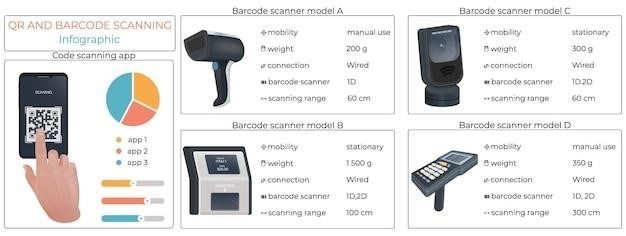
Honeywell UDC2500 Manual⁚ A Comprehensive Guide
This guide provides detailed instructions for installing, configuring, operating, and troubleshooting the Honeywell UDC2500 Universal Digital Controller. It covers specifications, Ethernet setup, safety, warranty, and accessing additional resources. Multiple versions exist; ensure you have the correct manual.
Introduction and Overview
The Honeywell UDC2500 Universal Digital Controller is a versatile and cost-effective solution for various industrial control applications. This manual serves as a comprehensive guide to understanding and utilizing its full potential. It’s designed to assist users of all levels, from novice operators to experienced technicians. The UDC2500 offers a range of features including multiple input/output options, flexible configuration settings, and robust communication capabilities. This document details installation procedures, operational instructions, and troubleshooting techniques to ensure seamless integration and optimal performance. Whether you’re a seasoned professional or new to the UDC2500, this manual provides the necessary information for successful implementation and ongoing maintenance. Remember to consult the appropriate version of the manual for your specific controller model, as features and specifications may vary slightly. Proper understanding of this manual is crucial for safe and efficient operation of the UDC2500.
Installation Procedures and Guidelines
Before commencing installation of the Honeywell UDC2500, carefully review all safety precautions outlined in this manual. Ensure the power supply is disconnected to prevent electrical hazards. Proper mounting is crucial for optimal performance and longevity. Follow the provided diagrams and instructions for secure mounting to a suitable surface. Accurate wiring is essential for correct functionality. Refer to the wiring diagrams and terminal assignments within this manual to ensure proper connections to sensors, actuators, and power sources. Double-check all connections before restoring power. After completing the physical installation, proceed to the configuration phase. Refer to the subsequent sections of this manual for detailed configuration instructions. Improper installation may lead to malfunction or damage to the unit. Always consult a qualified technician if you encounter any difficulties during the installation process. Detailed schematics and diagrams are provided to assist with the physical setup and wiring. Thorough inspection of all connections is recommended before powering on the UDC2500.
Configuration Options and Settings
The Honeywell UDC2500 offers extensive configuration options to tailor its functionality to your specific application needs. Access the configuration menu through the controller’s interface, typically using a keypad and display. Navigate the menu to adjust settings for input types (e.g., thermocouple, RTD, 4-20mA), output types (e.g., relay, 4-20mA), and control algorithms (e.g., PID, ON/OFF). Detailed descriptions of each parameter and their possible values are provided in the accompanying documentation. You can define alarm thresholds, set communication parameters (e.g., baud rate, parity), and configure logging options. A configuration record sheet is recommended to document your settings. This ensures accurate replication if necessary and aids in troubleshooting. Remember to save your configurations after making any changes. Incorrect settings can lead to inaccurate control or system malfunctions. Consult the manual’s dedicated section for comprehensive instructions and explanations of each configuration parameter. Pay close attention to the units of measurement to avoid errors; Always back up your configurations to prevent data loss.
Operational Procedures and Usage
Operating the Honeywell UDC2500 involves interacting with its user interface, typically a combination of keypad and display. The display shows the process variable, setpoint, output, and any active alarms. Basic operations include setting the desired setpoint, monitoring process variables, and adjusting control parameters as needed. The controller’s functionality extends to alarm management, data logging, and communication with external devices. Detailed operational procedures are outlined in the manual’s operational section, covering starting and stopping the controller, adjusting parameters during operation, and responding to alarms. Understanding the controller’s display indicators and their significance is crucial for effective operation. The manual describes the meaning of each display element and the actions required in various operational scenarios. Proper operational procedures ensure accurate process control and prevent damage to the controller or the controlled system. Be mindful of safety precautions and follow the guidelines specified in the manual. Regular checks of the controller’s status are recommended for optimal performance and early detection of potential problems. Consult the manual for guidance on advanced features and troubleshooting common operational issues. Remember to consult the manual for detailed instructions before attempting any complex operations.
Troubleshooting Common Issues
The Honeywell UDC2500 manual dedicates a section to troubleshooting common problems. This section provides a systematic approach to diagnosing and resolving issues, often using a flowchart or decision tree. Typical problems addressed include inaccurate readings, control loop instability, communication errors with external devices, and alarm conditions. The troubleshooting guide suggests checking wiring connections, sensor calibration, and controller settings as initial steps. For communication issues, it guides users through verification of network settings and cable connections. The manual may include diagnostic codes displayed on the controller’s screen, which help pinpoint the source of the problem. Each error code is explained, with suggested corrective actions. If the problem persists after following the suggested steps, the manual might recommend contacting Honeywell support or a qualified technician. The troubleshooting section emphasizes safety precautions, particularly when dealing with potentially hazardous process variables. It might detail procedures for safely shutting down the system during troubleshooting. Remember to always consult the complete manual for detailed steps and safety instructions. Comprehensive troubleshooting information is crucial for minimizing downtime and ensuring the continued reliable operation of the UDC2500 controller. The aim is to empower users to resolve common problems efficiently and safely.
Analog Input Specifications and Functionality
The Honeywell UDC2500 typically features two analog inputs, designed for connecting various sensors and transducers. The manual details the specifications of these inputs, including voltage ranges (e.g., 4-20 mA, 0-10V), impedance, and accuracy. Understanding these parameters is vital for selecting appropriate sensors and ensuring accurate measurements. The manual explains how to configure the analog input channels, specifying the type of signal (current or voltage), scaling factors, and engineering units. The sampling rate of the analog inputs is also specified, indicating how frequently the controller reads and processes the incoming signals. This information is crucial for determining the controller’s responsiveness to dynamic process changes. The manual might provide information on input filtering or noise reduction techniques to enhance measurement accuracy, especially in noisy environments. It may describe the use of signal conditioning modules or external components if necessary to adapt the sensor output to the controller’s input requirements. Furthermore, the document likely addresses the handling of potential input signal issues, such as signal overload or short circuits, and the corresponding error messages. Proper understanding of these specifications and the configuration procedures helps users optimize the controller’s performance and ensure reliable data acquisition from connected sensors. Detailed explanations of the analog input functionality are essential for effective use of the UDC2500.
Ethernet Communication Setup and Configuration
The Honeywell UDC2500 manual provides comprehensive instructions for establishing and configuring Ethernet communication. This section details the steps for assigning a static IP address to the controller, configuring subnet mask and gateway settings, and verifying network connectivity; It’s crucial to match the controller’s IP address with the network’s addressing scheme to ensure seamless communication with other devices like PCs or SCADA systems. The manual likely describes using specialized software, potentially Honeywell’s own, for configuring the Ethernet settings, allowing users to modify parameters such as communication protocols, baud rates, and data formats. Troubleshooting steps are also provided to address common connectivity issues, such as incorrect IP configurations or network cable problems. The process of checking network connectivity is explained, possibly through the use of diagnostic tools or commands. The manual may describe how to secure the Ethernet connection, for example, through password protection or enabling firewalls. It might also explain the various communication modes available, such as TCP/IP or UDP, along with their respective advantages and disadvantages. Understanding these procedures allows for effective integration of the UDC2500 into larger automation systems and provides the user with the skills for network maintenance and troubleshooting. The provided information should help users successfully connect and configure their UDC2500 for network communication.
Safety Precautions and Warnings
The Honeywell UDC2500 manual emphasizes the importance of adhering to strict safety procedures during installation, operation, and maintenance. Before commencing any task, ensure the power supply is disconnected to prevent electrical shocks. The manual likely highlights the potential hazards associated with high voltages and currents, advising users to exercise caution when working with wiring and connections. Appropriate personal protective equipment (PPE), such as insulated gloves and safety glasses, should always be worn. The document likely provides warnings about potential dangers from moving parts, hot surfaces, and hazardous materials, depending on the application environment. Clear and concise instructions on grounding and bonding procedures are essential to minimize risks associated with electrical faults. The manual should emphasize the importance of regularly inspecting the controller for any signs of damage or wear, promptly addressing any issues identified; Furthermore, the user manual should offer guidance on emergency procedures, including the correct shutdown sequence in case of malfunctions or unexpected events. Detailed instructions for proper disposal or recycling of the UDC2500 unit, considering its electronic components, are also likely included. The manual probably stresses that only qualified personnel with relevant training and experience should handle the installation and maintenance of the UDC2500, emphasizing the importance of following all local safety regulations and standards.
Warranty Information and Support
Honeywell’s warranty for the UDC2500, as indicated in various online sources, covers defects in materials and workmanship. The duration of this warranty likely varies depending on the region and specific purchase agreement. Details regarding the warranty period, coverage exclusions (e.g., damage due to misuse or improper installation), and the process for making a warranty claim should be clearly outlined in the official UDC2500 manual. The document probably explains how to obtain repair or replacement of defective components during the warranty period. Contact information for Honeywell’s customer support or technical assistance is crucial for resolving issues promptly. The user manual likely provides multiple avenues for seeking help, such as telephone numbers, email addresses, and potentially a website with FAQs and troubleshooting guides. Information on regional support centers or authorized service providers may also be included. For out-of-warranty repairs or support, the manual should provide details regarding service fees and procedures. It is important to note that the specifics of the warranty and support options may differ depending on the date of purchase and location. Therefore, carefully reviewing the warranty section of your specific UDC2500 manual is essential for understanding your rights and access to support services. Furthermore, the manual might detail procedures for registering your product, which may be a prerequisite for accessing certain support benefits or extending the warranty period.

Accessing the Manual and Additional Resources
Obtaining the Honeywell UDC2500 manual can often be achieved through several methods. The most straightforward approach is likely to check Honeywell’s official website. Their website might house a comprehensive library of product documentation, including manuals for various controllers, potentially searchable by model number. If the manual isn’t directly downloadable, contacting Honeywell’s customer support might be necessary to request a copy. Alternatively, searching online retailers or industrial automation distributors who sell the UDC2500 could provide access to the manual, either as a downloadable file or a physical document. Some distributors might even offer online previews of sections of the manual. Remember that different versions of the UDC2500 manual might exist, reflecting updates and revisions over time. Ensuring you’re using the most current version for your specific controller model is important for accurate information. Beyond the main manual, Honeywell may provide supplementary resources, such as quick start guides, application notes, or FAQs addressing common user issues. These additional resources can often be found on the same website where the main manual is hosted, and they can help users quickly get up to speed with the controller’s basic functionality. It’s also worth checking for any online forums or communities dedicated to Honeywell controllers, where users can share experiences, troubleshooting tips, and potentially even unofficial guides or supplemental information.
